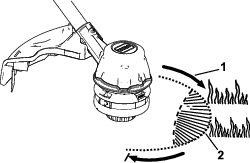Maintenance
After each use of the trimmer, complete the following:
-
Remove the battery from the trimmer.
-
Wipe the trimmer clean with a damp cloth. Do not hose the trimmer down or submerge it in water.
Caution
The line cutoff blade on the deflector is sharp and can cut you.
Do not use your hands to clean the deflector shield and blade.
-
Wipe or scrape clean the cutting head area any time there is an accumulation of debris.
-
Check and tighten all fasteners. If any part is damaged or lost, repair or replace it.
-
Brush debris away from air intake vents and exhaust on motor housing to prevent the motor from overheating.
Replacing the String
Important: Use only 2 mm (0.080 inch) diameter monofilament string (the manufacturer Part No. 88611) or 2.4 mm (0.095 inch) diameter twisted monofilament string (the manufacturer Part No. 88612).
-
Remove the battery pack and clean any debris from the trimmer head.
-
Remove any old string on the spool by repetitively pressing the bump button while pulling the line out equally from both sides of the trimmer.
-
Cut 1 piece of string according to the following specifications.
-
If you are using 2 mm (0.080 inch) string, cut one piece of line approximately 4.9 m (16 ft).
-
If you are using 2.4 mm (0.095 inch) twisted string, cut one piece of line approximately 3 m (10 ft).
Note: Do not use any other gauge or type of string, as this could damage the trimmer.
-
-
Press and turn the knob on the string head until arrow on the knob aligns with arrow on the string head (Figure 17).
-
Insert 1 end of the line at an angle into the LINE IN eyelet and push the line through the string head track until it comes out through the eyelet on the other side. Pull the line though the string head until the line outside the string is evenly divided on each side.


Important: Do not disassemble the trimmer head.
-
Hold the string head in place with one hand. With your other hand, rotate the knob in the direction shown by the arrows (counterclockwise).
-
Wind the line, leaving about 102 mm (4 inches) extending beyond the eyelet on each side.
Storage
Important: Store the tool, battery pack, and charger only in temperatures that are within the appropriate range; refer to Specifications.
Important: If you are storing the battery pack for the off-season, charge it until 2 or 3 LED indicators turn green on the battery. Do not store a fully charged or fully depleted battery. When you are ready to use the machine again, charge the battery pack until the left indicator light turns green on the charger or all 4 LED indicators turn green on the battery.
-
Disconnect the product from the power supply (i.e., remove the plug from the power supply or the battery pack) and check for damage after use.
-
Do not store the machine with the battery pack installed.
-
Clean all foreign material from the product.
-
When not in use, store the tool, battery pack, and battery charger out of the reach of children.
-
Keep the tool, battery pack, and battery charger away from corrosive agents, such as garden chemicals and de-icing salts.
-
To reduce the risk of serious personal injury, do not store the battery pack outside or in vehicles.
-
Store the tool, battery pack, and battery charger in an enclosed clean, dry area.
Preparing the Battery Pack for Recycling
Important: Upon removal, cover the terminals of the battery pack with heavy-duty adhesive tape. Do not attempt to destroy or disassemble the battery pack or remove any of its components.
 |
Lithium-ion battery packs labeled with the Call2Recycle seal can be recycled at any participating retailer or battery recycling facility in the Call2Recycle program (US and Canada only). To locate a participating retailer or facility closest to you, please call 1-800-822-8837 or visit www.call2recycle.org. If you cannot locate a participating retailer or facility nearby, or if your rechargeable battery is not labeled with the Call2Recycle seal, please contact your local municipality for more information on how to responsibly recycle the battery. If you are located outside of the US and Canada, please contact your authorized Toro distributor. |
























